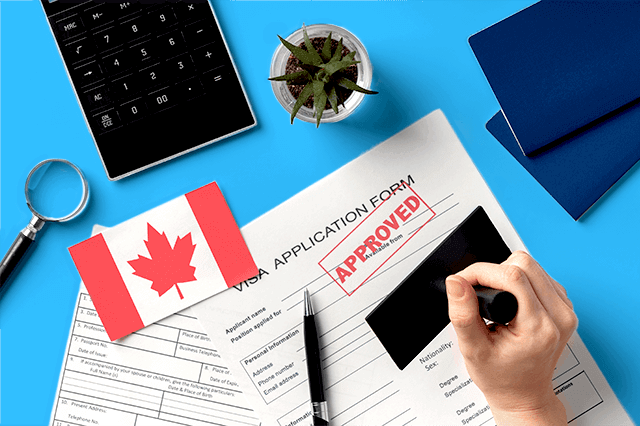
How to Immigrate to Canada Without a Job Offer in 2023
Embarking on your Canadian journey without a job offer is a possibility that many aspiring immigrants explore. Canada’s immigration system offers multiple pathways to make this dream come true. The Immigration, Refugees, and Citizenship Canada (IRCC) manages various visa types for immigrants, including the immigrant visa category. To successfully immigrate, it’s essential to understand the different requirements and qualifications for each visa type. Among the available options, the study visa pathway stands out as a promising route. Pursuing higher education in Canada can lead to permanent residency, making it an attractive choice for those seeking to call Canada their home.
Are you considering making Canada your new home but worried about the complexities of securing a job offer beforehand? Fret not, as Canada offers various immigration streams that don’t require a job offer, making the process more accessible to skilled workers, students, and entrepreneurs alike. In this comprehensive guide, we’ll explore the different migration pathways and put a spotlight on the Study Visa pathway, a popular choice for many aspiring immigrants. So, if you’re ready to embark on your Canadian dream, keep reading!
Top Three Ways to Immigrate to Canada without a Job Offer
Each of these immigration pathways has its unique requirements and advantages, catering to diverse circumstances and qualifications. Whether you’re a skilled professional, have family ties in Canada, or seek educational opportunities, these top three ways provide promising avenues to fulfill your Canadian aspirations.
1. Express Entry
The Express Entry System managed by the Immigration, Refugees, and Citizenship Canada (IRCC) is one of the most sought-after pathways for skilled workers. Through the Federal Skilled Worker Program (FSWP), Federal Skilled Trades Program (FSTP), and Canadian Experience Class (CEC), candidates can enter the pool and are ranked based on factors like age, education, work experience, and language proficiency. The highest-ranking candidates are then invited to apply for permanent residency.
2. Family Sponsorship
If you have close family members who are Canadian citizens or permanent residents, the Family Sponsorship program offers a viable path to immigration. Eligible family members, including spouses, partners, dependent children, parents, and grandparents, can be sponsored by their Canadian relatives for permanent residency in Canada.
3. Study Pathway
If you’re someone looking to pursue higher education in Canada, the Study Visa pathway could be your ticket to living and working in the country. Apart from the opportunity to study at a prestigious Canadian institution, this pathway opens doors to gain valuable work experience and eventually transition to permanent residency.
The Study Visa Pathway: A Stepping Stone to Canadian PR
The study pathway is the best option for those without a job offer because it not only allows individuals to pursue higher education in Canada but also provides an opportunity to gain valuable work experience. By obtaining a study permit, students can work on or off-campus during their studies, which enhances their chances of qualifying for the Canadian Experience Class (CEC) stream or the Post-Graduation Work Permit (PGWP). The PGWP allows graduates to work in Canada for up to three years, increasing their eligibility for permanent residency through the Express Entry system or other provincial nomination programs.
Here’s a step-by-step guide on how this pathway can lead you to Canadian permanent residency:
Step 1: Research Canadian Institutions
Start by researching and selecting a Designated Learning Institution (DLI) in Canada. DLIs are approved by provincial or territorial authorities to host international students.
Step 2: Apply for Admission
Once you’ve chosen a program and institution, apply for admission. Ensure that you meet all the academic requirements and have sufficient financial resources to cover your tuition fees and living expenses.
Step 3: Obtain a Study Permit
After receiving an acceptance letter from the DLI, apply for a study permit. You’ll need to provide proof of funds, a valid passport, and other required documents during the application process.
Step 4: Study and Work in Canada:
Upon receiving your study permit, you can travel to Canada and begin your academic journey. Most study permits also allow you to work on or off-campus, giving you an opportunity to gain valuable work experience.
Step 5: Post-Graduation Work Permit (PGWP)
Upon completing your studies, you may be eligible for a PGWP, which allows you to work in Canada for up to three years. This work experience can be crucial in qualifying for permanent residency through the Express Entry system or the Canadian Experience Class (CEC) stream.
Need guidance with your study visa application?
Step 6: Express Entry or Provincial Nominee Program (PNP)
With your Canadian education and work experience, you can earn valuable points for your Express Entry profile or secure a provincial nomination through PNP. These points significantly improve your chances of receiving an Invitation to Apply (ITA) for permanent residency.
Step 7: Apply for Permanent Residency
Once you receive an ITA, you can apply for permanent residency. After a successful application, you’ll be granted the status of a permanent resident of Canada.
While having a job offer can be beneficial, Canada offers several avenues for immigration without one. The study visa pathway stands out as a viable option, enabling you to pursue higher education, gain Canadian work experience, and eventually transition to permanent residency. With the right guidance and determination, you can turn your Canadian dream into a reality.
Remember, the immigration process can be complex, so seeking assistance from experienced professionals can make a significant difference in your journey. Let Expedite Visa be your trusted partner in making your immigration journey smooth and successful. Contact us today and let us help you turn your aspirations into reality in the land of opportunities – Canada!